PONTIAC GRAND-PRIX 1993 Owners Manual
Manufacturer: PONTIAC, Model Year: 1993, Model line: GRAND-PRIX, Model: PONTIAC GRAND-PRIX 1993Pages: 338, PDF Size: 17.3 MB
Page 251 of 338
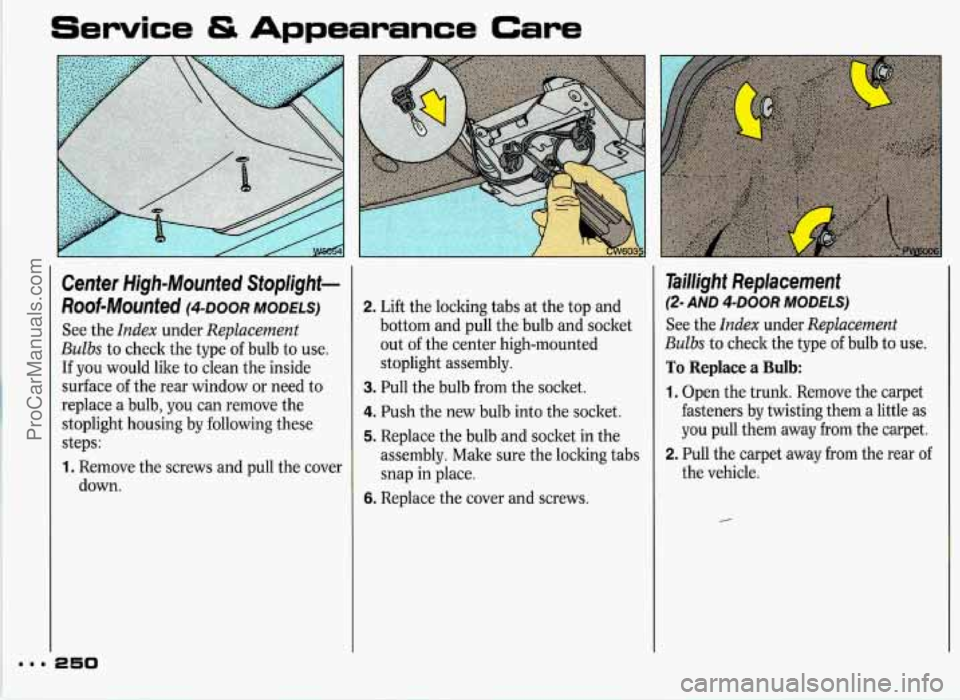
Service & Appearance Care
I
~
..I
Center High-Mounted Stoplight-
Roof-Mounted
DOOR MODELS)
See the Index under Replacement
Bulbs
to check the type of bulb to use.
If you would like to clean the inside
surface of the rear window or need to
replace a bulb, you can remove the
stoplight housing by following these
steps:
I. Remove the screws and pull the cover
down.
250
2. Lift the locking tabs at the top and
bottom and pull the bulb and socket
out of the center high-mounted
stoplight assembly.
3. Pull the bulb from the socket.
4. Push the new bulb into the socket.
5. Replace the bulb and socket in the
assembly. Make sure the locking tabs
snap in place.
6. Replace the cover and screws.
Taillight Replacement
(2- AND 4-DOOR MODELS)
See the Index under Replacement
Bulbs
to check the type of bulb to use.
To Replace a Bulb:
1. Open the trunk. Remove the carpet
fasteners by twisting them
a little as
you pull them away from the carpet.
2. Pull the carpet away from the rear of
the vehicle.
ProCarManuals.com
Page 252 of 338
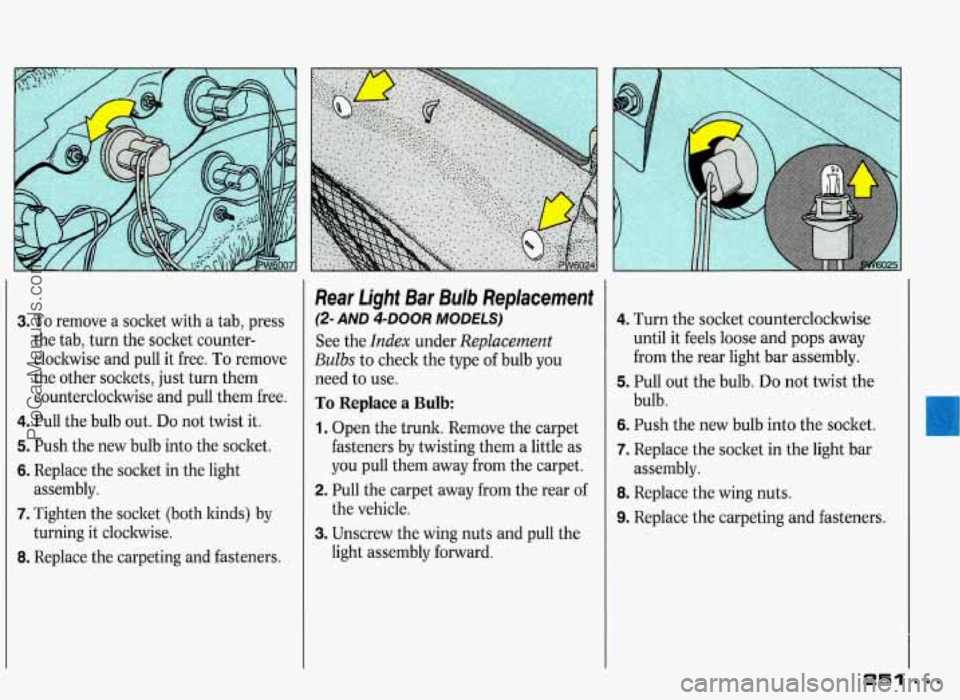
3. To remove a socket with a tab, press
the tab, turn the socket counter-
clockwise and pull it free. To remove
the other sockets, just turn them
countercloclwise and pull them free.
4. Pull the bulb out. Do not twist it.
5. Push the new bulb into the socket.
6. Replace the socket in the light
7. Tighten the socket (both kinds) by
8. Replace the carpeting and fasteners.
assembly.
turning it clockwise.
Rear Light Bar Bulb
Replacement
(2- AND 4-DOOR MODELS)
See the Index under Replacement
Bulbs to check the type of bulb you
need to use.
To Replace a Bulb:
1. Open the trunk. Remove the carpet
fasteners by twisting them a little as
you pull them away from the carpet.
2. Pull the carpet away from the rear of
the vehicle.
3. Unscrew the wing nuts and pull the
light assembly forward.
4. Turn the socket countercloclrwise
until it feels loose and
pops away
from the rear light bar assembly.
5. Pull out the bulb. Do not twist the
bulb.
6. Push the new bulb into the socket.
7. Replace the socket in the light bar
8. Replace the wing nuts.
9. Replace the carpeting and fasteners.
assembly.
251
ProCarManuals.com
Page 253 of 338
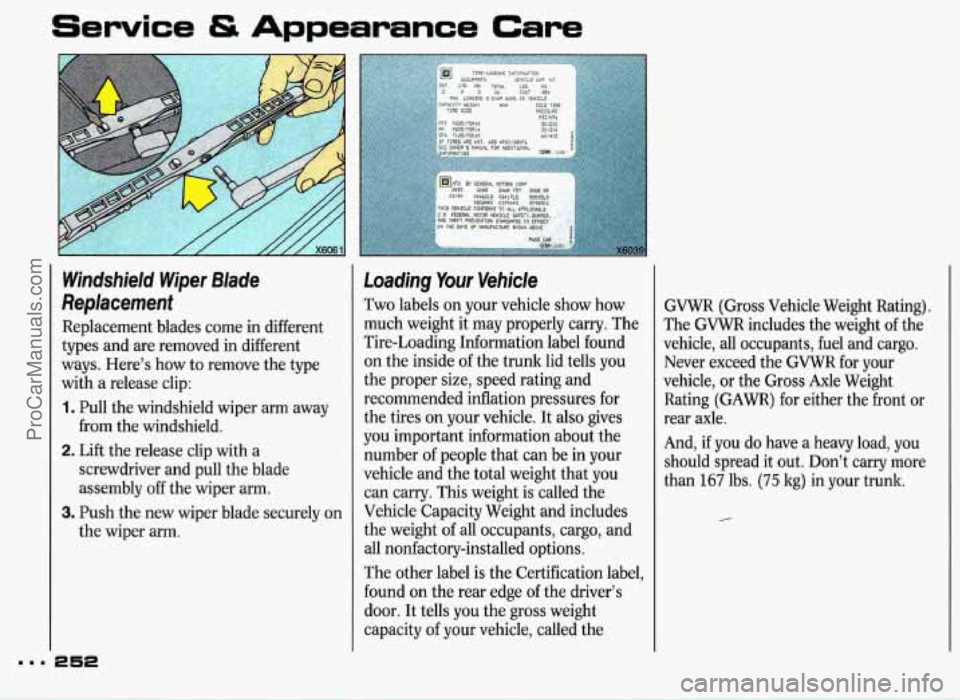
aam
Service & Appearance Care
Windshield Wiper Blade
Replacement
Replacement blades come in different
types and are removed in different
ways. Here’s how to remove the type
with
a release clip:
1. Pull the windshield wiper arm away
2. Lift the release clip with a
from the
windshield.
screwdriver and pull the blade
assembly off the wiper arm.
the wiper arm.
3. Push the new wiper blade securely on
252
Loading Your Vehicle
Two labels on your vehicle show how
much weight it may properly carry. The
Tire-Loading Information label found
on the inside of the trunk lid tells you
the proper size, speed rating and
recommended inflation pressures for
the tires on your vehicle. It also gives
you important information about the
number of people that can be in your
vehicle and the total weight that you
can carry. This weight is called the
Vehicle Capacity Weight and includes
the weight of all occupants, cargo, and
all nonfactory-installed options.
The other label is the Certification label,
found on the rear edge of the driver’s
door. It tells you the gross weight
capacity of your vehicle, called the GVWR
(Gross Vehicle Weight Rating).
The GVWR includes the weight of the
vehicle, all occupants, fuel and cargo.
Never exceed the GVWR for your
vehicle, or the Gross Axle Weight
Rating (GAWR) for either the front or
rear axle.
And,
if you do have a heavy load, you
should spread it out. Don’t carry more
than
167 lbs. (75 kg) in your trunk.
ProCarManuals.com
Page 254 of 338
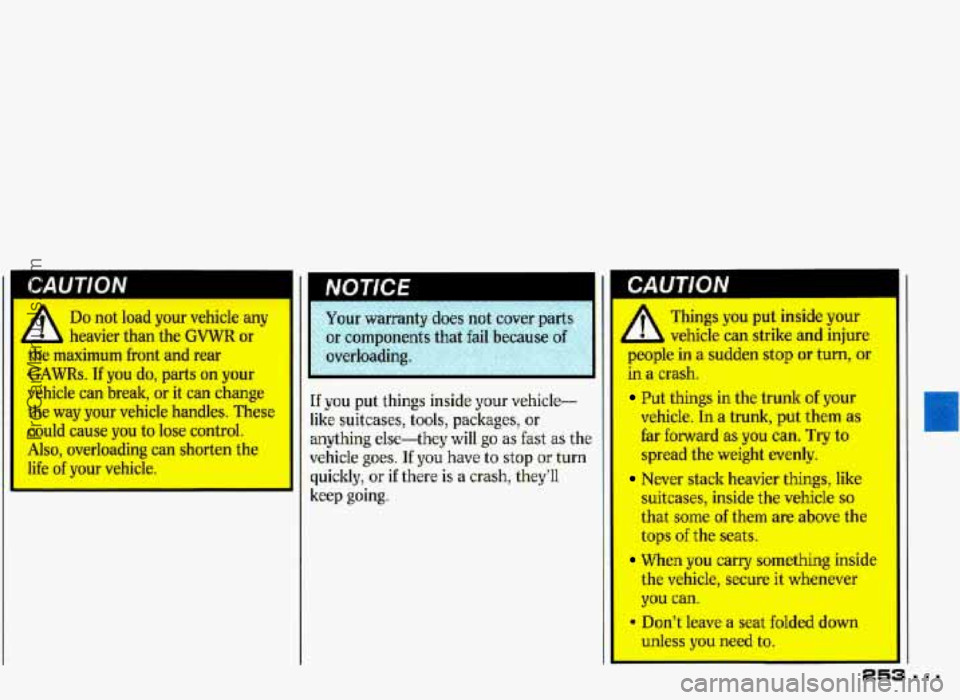
I
the way your vehicle handles. These
could cause you to lose control.
Also, overloading can shorten the
life
of vour vehicle.
I
r
Do not load your vehicle any
l heavier than the GVWR or
the maximum front and rear
GAWRs.
If you do, parts on your
vehicle can break, or it can change
our warranty does not cover parts
or components that fail because of
If YQU put things inside your vehicle-
like suitcases,
tools, packages, or
anything else-they will go as fast as the
vehicle goes. If you have to stop or turn
quickly, or if there is a crash, they’ll
keep going. Things
you put inside your
vehicle can strike and injure
PI- ,,le in a sudden stop or turn, or
in a crash.
Put things in the trunk of your
vehicle. In a trunk, put them as
far forward as you can. Try to
spread the weight evenly.
Never
stack heavier things, like
suitcases, inside the vehicle so
that some of them are above the
tops of the seats.
When you carry something inside
the vehicle, secure it whenever
you can.
* Don’t leave a seat folded down
unless you need to.
ProCarManuals.com
Page 255 of 338
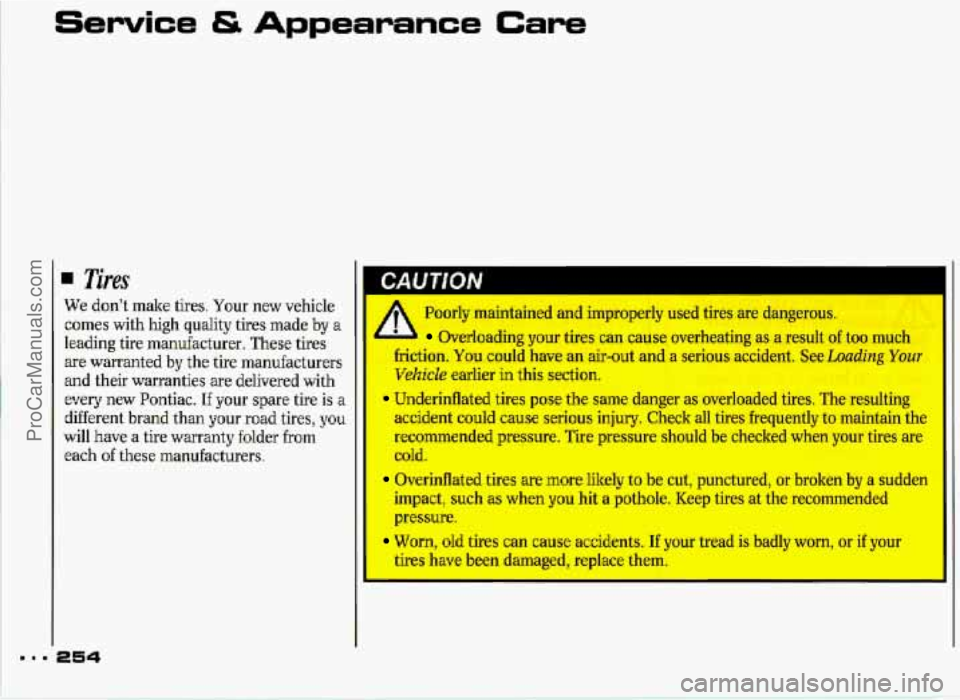
Service & Appearance Care
4 Tires
We don't make tires. Yo'ur new vehicle
comes with
high quality tires made by a
leading tire manufacturer. These tires
are warranted
by the tire manufacturers
and their warranties are delivered with
every
new Pontiac. If your spare tire is a
different brand than your road tires, you
will have a tire warranty folder from
each of these manufacturers.
254
1 A, Poorly maintained armd improperly used tires are dangerous.
b Overloading your tires can cause overheating as a result of too much
friction. YOU could have an &-out and a serious accident. See Loading Your
Vehicle earlier in this section.
accident
could cause serious injury. Check all tires frequently to maintain the
recommended
pressure. Tire pressure should be checked when your tires are
cold.
Overinflated tires are more Likely to be cut, punctured, or broken by a sudden
impact, such as when you hit a pothole. Keep tires at the recommended
pressure.
Worn, old tires can cause accidents. If your tread is badly worn, or if your
tires have been damaged, replace them.
Underinflated tires pose the same danger as overloaded tires. The resulting
ProCarManuals.com
Page 256 of 338
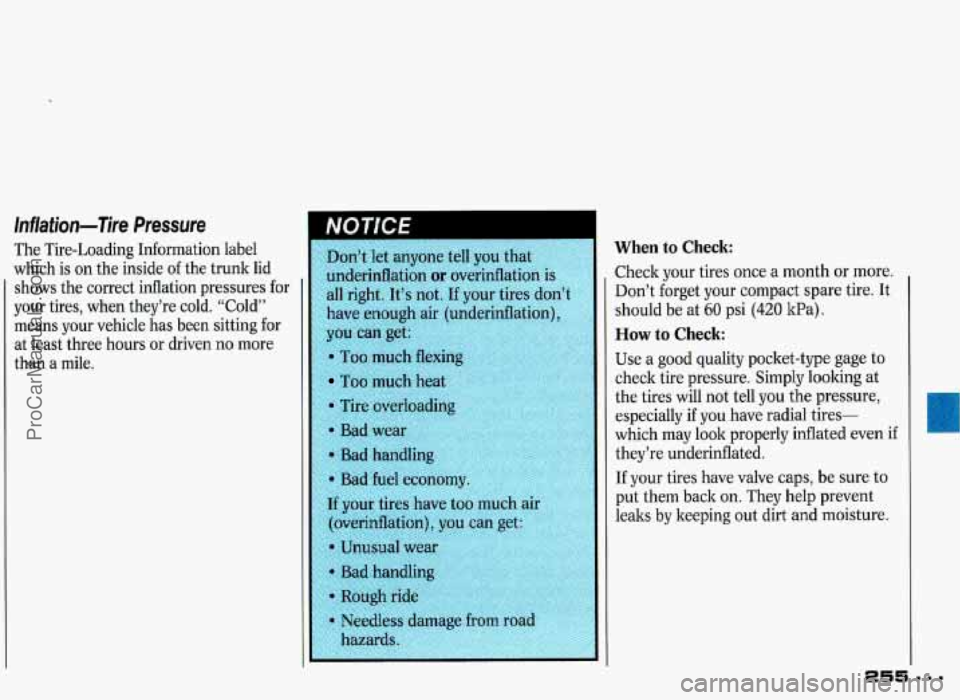
Inflation-Tire Pressure
The Tire-Loading Information label
which is on the inside of the trunk lid
shows the correct inflation pressures for
your tires, when they’re cold. “Cold”
means your vehicle has been sitting for
at least three hours or driven
no more
than a mile. Don’t let anyone
tell you th
underinflation
or overinflati
all right. It’s not.
If your tires d
have enough air (underinflation
Too much heat
If your tires have too much air
When to Check:
Check your tires once a month or more.
Don’t forget your compact spare tire. It
should be at
60 psi (420 ItPa).
How to Check:
Use a good quality pocket-type gage to
check tire pressure. Simply loolting at
the tires will not tell you the pressure,
especially if you have radial tires-
which may
look properly inflated even if
they’re underinflated.
If your tires have valve caps, be sure to
put them back on. They help prevent
leaks by keeping out dirt
and moisture.
ProCarManuals.com
Page 257 of 338
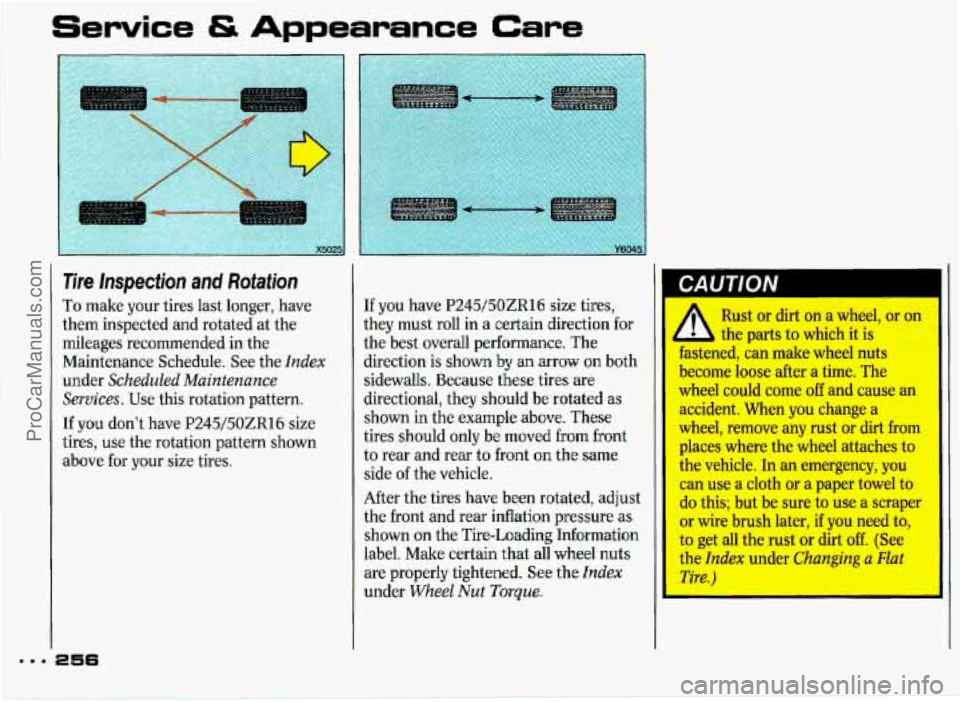
§ervice & Appearance Care
.a.
.............. ............. .... ............
Tire Inspection and Rotation
To make your tires last longer, have
them inspected and rotated at the
mileages recommended in the
Maintenance Schedule. See the
Index
under Scheduled Maintenance
Services.
Use this rotation pattern.
If you don't have P245/50ZR16 size
tires, use the rotation pattern shown
above for your size tires.
256
If you have P245/510ZR16 size tires,
they must roll
in a certain 'direction for
the best overall performance. The
direction is shown
by an arrow on both
sidewalls. Because these tirles are
directional, they should be rotated
as
shown in the example above. These
tires should only be moved
from front
to rear and rear to front
on the same
side
of the vehicle.
After the tires have been rotated, adjust
the front and rear inflation pressure as
shown
on the Tire-Loading Information
label. Make certain that
all wheel nuts
are properly tightened. See the Index
under Wheel Nut Torque.
Rust or dirt on a wheel, or on
ri the parts to which it is
fastened, can make wheel nuts
become loose after a time. The
wheel could come off and cause an
accident. When you change a
wheel, remove any rust or dirt from
places where the wheel attaches to
the vehicle. In an emergency,
you
can use a cloth or a paper towel to
do this; but be sure to use a scraper
or wire brush later,
if you need to,
to get all the rust or dirt off. (See
the
Index under Changing a Flat
Tire.)
ProCarManuals.com
Page 258 of 338
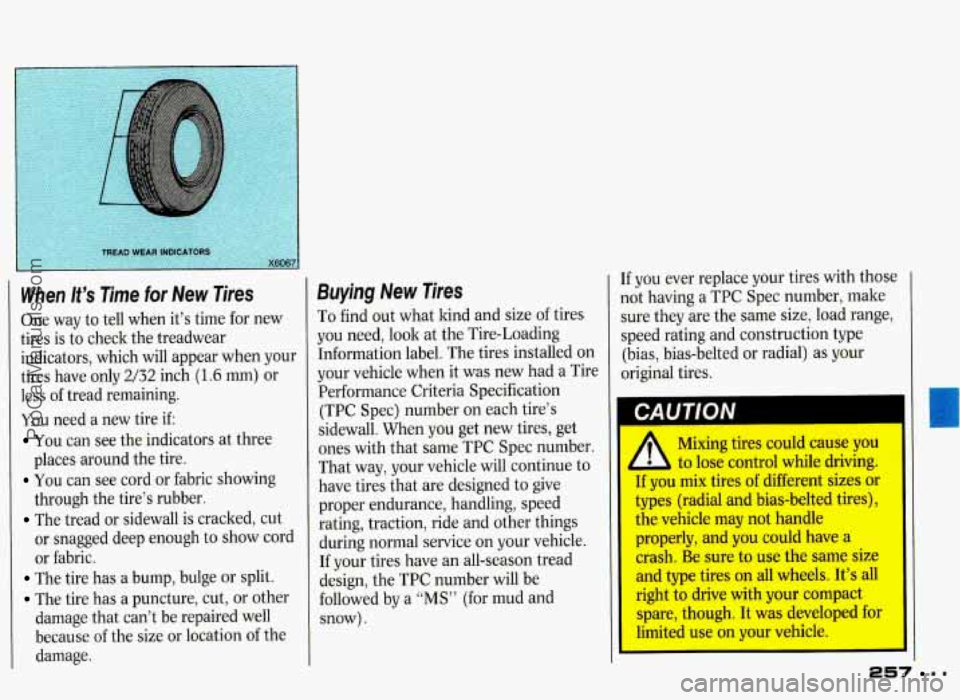
When It’s Time for New Tires
One way to tell when it’s time for new
tires is to check the treadwear
indicators, which will appear when your
tires have only
2/32 inch (1.6 mm) or
less
of tread remaining.
You need a new tire if:
You can see the indicators at three
You can see cord or fabric showing
The tread or sidewall is cracked, cut
places
around the tire.
through the tire’s rubber.
or snagged deep enough to show cord
or fabric.
The tire has a bump, bulge or split.
The tire has a puncture, cut, or other
damage that can’t
be repaired well
because
of the size or location of the
damage.
Buying New Tires
To find out what kind and size of tires
you need, look at the Tire-Loading
Information label. The tires installed on
your vehicle when it was new had a Tire
Performance Criteria Specification
(TPC Spec) number on each tire’s
sidewall. When
you get new tires, get
ones with that same
TPC Spec number.
That way, your vehicle will continue to
have tires that are designed to give
proper endurance, handling, speed
rating, traction, ride and other things
during normal service on your vehicle.
If your tires have an all-season tread
design, the
TPC number will be
followed by a
“MS” (for mud and
snow). If
you ever replace your tires with those
not having a
TPC Spec number, make
sure they are the same size, load range,
speed rating and construction type
(bias, bias-belted or radial) as your
original tires.
‘1 Mixing tires could cause you
A to lose control while driving.
If you mix tires
of different sizes or
types (radial and bias-belted tires),
the vehicle may not handle
properly, and you could have a
crash. Be sure to use the same size
and type tires on all wheels. It’s all
right to drive with your compact
spare, though. It was developed for
limited use on vour vehicle.
r
257 =a
ProCarManuals.com
Page 259 of 338
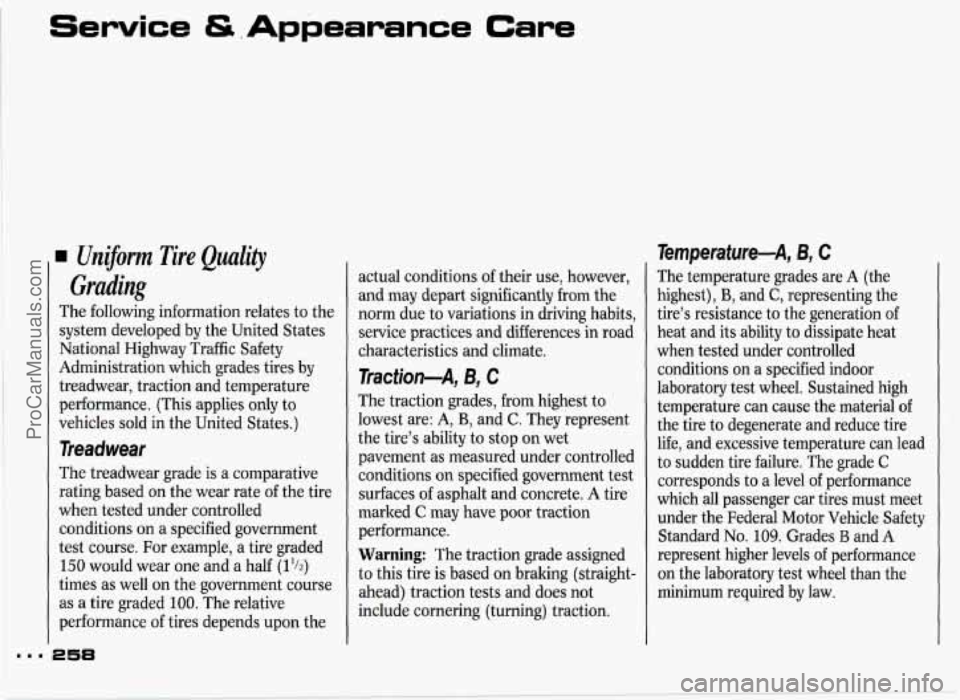
Service &.Appearance Care
Grading
The following information relates to the
system developed by the United States
National Highway Traffic Safety
Administration which grades tires by
treadwear, traction and temperature
performance. (This applies only to
vehicles sold in the United States.)
Treadwear
The treadwear grade is a comparative
rating based on the wear rate of the tire
when tested under controlled
conditions
on a specified government
test course. For example, a tire graded
150 would wear one and a half (1%)
times as well on the government course
as a tire graded
100. The relative
performance
of tires depends upon the actual conditions
of their use, however,
and may depart significantly from the
norm due to variations in driving habits,
service practices and differences in road
characteristics and climate.
Traction-A, B, C
The traction grades, from highest to
lowest are:
A, B, and C. They represent
the tire’s ability to stop on
wet
pavement as measured under controlled
conditions
on specified government test
surfaces of asphalt and concrete.
A tire
marked
C may have poor traction
performance.
Warning: The traction grade assigned
to this tire is based on braking (straight-
ahead) traction tests and does not
include cornering (turning) traction.
Temperature-A, B, C
The temperature grades are A (the
highest),
€3, and C, representing the
tire’s resistance to the generation of
heat and its ability to dissipate heat
when tested under controlled
conditions on a specified indoor
laboratory test wheel. Sustained high
temperature can cause the material of
the tire to degenerate and reduce tire
life, and excessive temperature can lead
to sudden tire failure. The grade
C
corresponds to a level of performance
which all passenger car tires must meet
under the Federal Motor Vehicle Safety
Standard
No. 109. Grades B and A
represent higher levels of performance
on the laboratory test wheel than the
minimum required by law.
ProCarManuals.com
Page 260 of 338
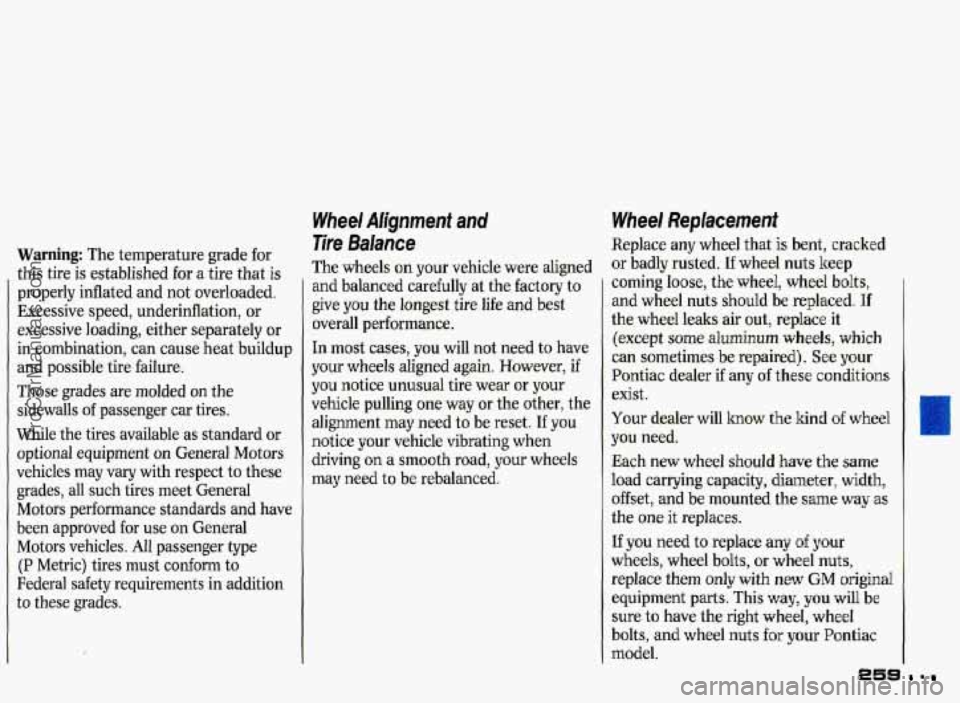
Warning: The temperature grade for
this tire is established
for a tire that is
properly inflated and not overloaded.
Excessive speed, underinflation, or
excessive loading, either separately or
in combination, can cause heat buildup
and possible tire failure.
Those grades are molded
on the
sidewalls of passenger car tires.
While the tires available as standard or
optional equipment
on General Motors
vehicles may vary with respect to these
grades, all such tires meet General
Motors performance standards and have
been approved for use on General
Motors vehicles.
All passenger type
(P Metric) tires must conform to
Federal safety requirements in addition
to these grades.
Wheel AIignrnenf and
Tire Balance
The wheels on your vehicle were aligned
and balanced carefully at the factory to
give you the longest tire life and best
overall performance.
In most cases, you will not need to have
your wheels aligned again. However, if
you notice unusual tire wear or your
vehicle pulling one way
or the other, the
alignment may need to be reset. If
you
notice your vehicle vibrating when
driving
on a smooth road, your wheels
may need to be rebalanced.
Wheel Replacement
Replace any wheel that is bent, cracked
or badly rusted.
If wheel nuts keep
coming loose, the wheel, wheel bolts,
and wheel nuts should be replaced. If
the wheel leaks air out, replace it
(except some aluminum wheels, which
can sometimes be repaired). See your
Pontiac dealer if any
of these conditions
exist.
Your dealer will how the kind
~f wheel
you need.
Each new wheel should
have the same
load carrying capacity, diameter, width,
offset, and be mounted the same way as
the one it replaces.
If
you need to replace any of your
wheels, wheel bolts, or wheel nuts,
replace them only with
new GM original
equipment parts. This
way, you will be
sure
to have the right wheel, wheel
bolts, and wheel nuts
for your Pontiac
model.
259
ProCarManuals.com